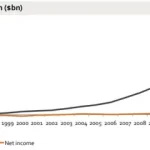The mission statement on music company Spotify’s website is exciting but very ambitious:
“Millions of tracks, any time you like. Just search for it in Spotify, then play it. Just help yourself to whatever you want, whenever you want it.”
As desirable as that sounds, any company in the music industry faces some significant challenges. For one, it is very difficult to set up a legal service without being crippled by licensing fees by the major record labels. And individuals can fairly easily resort to piracy to obtain the content, so it can be difficult to get them to agree to pay anything at all.
But people want to enjoy music legally (most of them, anyway), and we’re always looking for innovative, flexible and affordable ways to do it. Spotify might prove to be all of that, and to cap it all off, they might even prove to be profitable.
A Look at Spotify’s Business Model
So how is Spotify able to differentiate itself from music giant iTunes, as well as services such as Pandora, Last.Fm, Groveshark and others? To understand this, we’ll first have to unpack how exactly the business works.
Spotify is a subscription streaming music service, which is fundamentally different from iTunes where songs and albums are individually purchased. For revenue, they utilize the “freemium” model alongside advertisements.
There are three levels of Spotify accounts. The Free subscription is exactly what it promises, but it has banner and audio advertisements and you cannot take the music on your mobile device. Also, although it isn’t mentioned on the sales page, a look in the Terms of Service reveals that after a 6 month trial phase, free accounts are limited to “10 listening hours per month and a cap of 5 plays per unique track.”
This can be an effective way to convert free users to premium subscribers, a goal we will further explore later on. After you get used to unlimited music over a 6 month period, it is very tempting to pony up a few dollars per month to continue it.
Spotify’s music streaming is also well integrated into major mobile operating systems including iOS, Android, WebOS, Windows Phone and more. Many users will purchase the Unlimited or Premium subscription because they want to listen to their songs on their smartphone or tablet.
The mobile compatibility coupled with their growing music library, which is already over 15 million songs, makes Spotify stand out from its streaming competitors.
Spotify’s Social Media Integration
Another major selling point for Spotify is the integration with Facebook for social music sharing and discovery. Spotify declares itself the “soundtrack to your social life” and touts the benefits of getting music recommendations from your friends rather than a computer algorithm.
You can see what tracks your friends are listening to, find out what is “trending” and even collaborate on shared playlists. This is such a vital part of the Spotify experience that they actually require new users to connect via Facebook to open an account.
But does this rule alienate users who aren’t big fans of Facebook, or those who don’t want to be bombarded with song recommendations from hundreds friends and acquaintances?
The Facebook connection is a calculated decision, and it’s a big part of Spotify’s overall business strategy. With any freemium model, the major goal is to convert free users to paid subscribers, and also to provide increased value over time. (source)
Business Insider says that Spotify’s impressive conversion rate so far is a product of the “emotional connection” they make with users.
Sharing Spotify songs with your Facebook friends, taking hours to create playlists, and discovering awesome new music through Spotify are all big parts of this emotional connection, and they explain why users’ perceived value of the service increases the longer they have been using it.
A Music “Platform”
Spotify just recently made the announcement that it would open up its music library API for third-party developers to create their own apps. Some companies have already created apps, such as Rolling Stone which offers music reviews and playlists selected by its staff writers.
This big move transforms Spotify into a true music platform, one that can be leveraged by partners and other businesses, and one for which developers will create some amazing apps that will enrich our music experience in new ways.
(To read more about the significance of the platform business model, check out the book Age of the Platform by Phil Simon (aff link).)
Important Challenges to the Spotify Model
Another key factor in the long-term profitability of Spotify is having a low marginal cost per subscriber, which means how cheap it is to add each additional paying user. The terms of their music licensing agreements are not completely known, so it is unclear whether what they are paying for different types of subscribers, as well as costs for streaming format compared to file downloads.
At least one report takes a negative take on this:
“The way music licensing has traditionally worked, Spotify would be paying the labels and publishers the same rate for all songs that users stream on the service — whether they’re getting them for free or paying. That’s insane.” (source)
Whether or not this is actually the case isn’t known, but licensing terms are undoubtedly a significant challenge for Spotify.
In addition, Apple’s main advantage is that they also have the iPod to sell alongside the songs, so they make money on both the device and the content. Spotify does not have that luxury, so they need to build an enormous user base and convert a high percentage to the premium service.
They also will likely face pressure from the music industry. Last year, the CEO of Warner Music called free streaming services “not a net positive for the industry.”
And finally, in a great blog post, James Allworth explains why he is wary of the monthly subscription model, and the fact that users are “renting” the music instead of purchasing a file they can transfer, archive and use wherever you want. He also compares Spotify to Netflix, and points out a potential backlash if (or when) Spotify decides to hike up the price. (There is also a very critical comment at the bottom of the post which offers an alternative perspective.)
Whatever your opinion, Spotify’s innovations are harnessing the social web to bring lots of music to us at a cheap price, and also giving us ways to connect and share around that music.




Leave a Reply